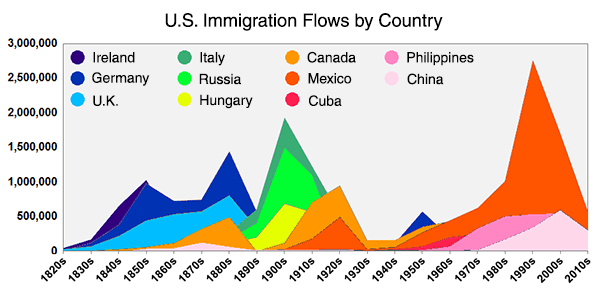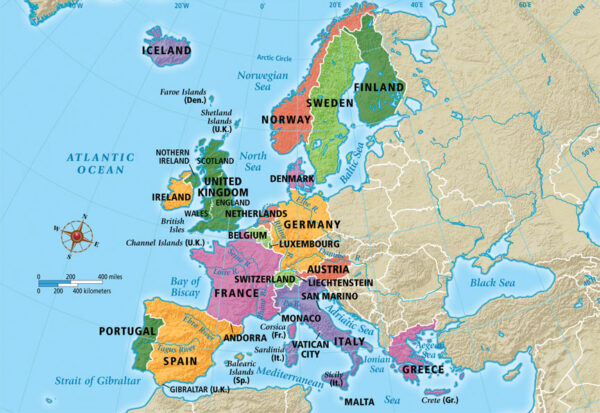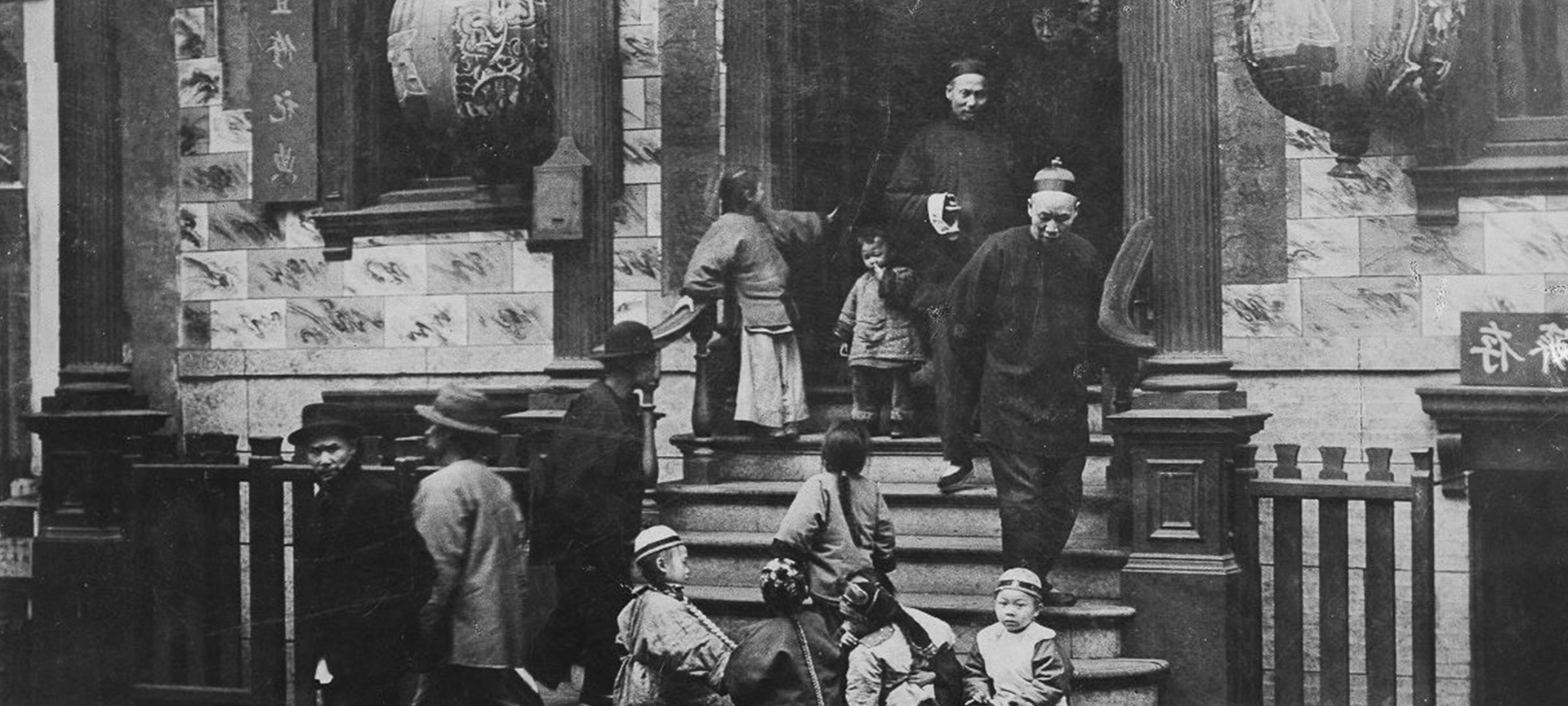1. Immigration: High Hopes & Hard Realities
After completing this or multiple sections of this lesson plan, please take 5 minutes to complete the survey at the bottom of this page. Your feedback will be extremely valuable for future curriculum updates and additions.
Motivational Activity
Select individual students to read aloud each of the quotations below. Then ask the class the questions that follow as a basis for a classroom conversation.
George Washington:
“The bosom of America is open to receive not only the Opulent and respected Stranger, but the oppressed and persecuted of all Nations and Religions; whom we shall welcome to a participation of all our rights and privileges…”
John F. Kennedy:
“Everywhere immigrants have enriched and strengthened the fabric of American life.”
“We are a nation of immigrants.”
George W. Bush:
“Nearly all Americans have ancestors who braved the oceans – liberty-loving risk takers in search of an ideal… Immigration is not just a link to America’s past; it’s also a bridge to America’s future.”
Barack Obama:
“We are and always will be a nation of immigrants.”
To the teacher: It is important at this stage to note to the class that immigration is a sensitive contemporary issue. We suggest you address this prior to next steps, saying something to the students such as, “Today we’re going to be discussing immigration, a topic that is part of our current conversation as a country, and is sometimes tied to racism and prejudice. Let’s keep that in mind as we start and take care to consider the subject thoughtfully and critically. Just as important to note is that the growth patterns of the United States are linked to demographic changes beyond immigration, including the forced migrations of enslaved people to the U.S. in the 18th and 19th Centuries.”
Questions for Students:
- What is an immigrant?
- Are the viewpoints expressed in these quotes in favor of or opposed to immigration?
- When Barack Obama and John F. Kennedy use the term “a nation of immigrants” to describe the United States, what do you think they mean?
- How has the United States lived up to the sentiments above? How has it fallen short?
- Does anyone have a family connection to immigration? Can you share your family’s immigrant story? Explain where your family comes from and how you maintain a connection to that place and culture while also being part of America.
To the teacher: Explain to students that this lesson unit focuses on Yogi Berra, the legendary baseball player whose father, Pietro, came to the United States from Italy in 1909. Like many immigrants at the time, Pietro arrived in New York City after a long boat journey from Europe. He was first registered on Ellis Island, in the shadow of the Statue of Liberty, where immigrants were screened, sometimes detained and occasionally sent back to their homelands.
Part 1A
Give students Handout #1, which includes the cover image of John F. Kennedy’s book A Nation of Immigrants and an excerpt from Emma Lazarus’s poem “The New Colossus.” After they’ve had a chance to consider the image and read the poem to themselves, ask the questions that follow:
Questions for Students:
- Why do you think Kennedy includes a picture of the Statue of Liberty on the cover of A Nation of Immigrants?
- What do you think the statue is meant to symbolize?
- What values does Emma Lazarus attribute to the Statue of Liberty?
- What is the poet’s vision of the United States as an immigrant destination?
- Who do you think Lazarus is referring to when she writes, “your tired, your poor/ Your huddled masses yearning to breathe free”?
- Do you think the United States has lived up to Lazarus’ vision of America in the poem from Yogi’s time? Does the U.S. do so today?
To the teacher: Inform the class that the National Park Service refers to the Statue of Liberty as the following: “‘The Immigrant’s Statue’ . . . a reassuring sign that [immigrants] had arrived in the land of their dreams.”
Making Connections: What are your family’s roots? Do you have an immigrant experience in your family history? Were your ancestors enslaved people? You might have an “immigrant story” yourself. If you recently traveled to the U.S. from another country, or as a “migrant” from another region within the country, reflect on what has been positive and what has been challenging about that experience. Have a conversation with your parent, another relative or a neighbor, asking them about their “immigrant story.” Bring one of these to share with the class.
Part 1B:
Have students break into small groups. Give each group a copy of Handout #2, which includes six political cartoons from the late 19th and early 20th Centuries, along with questions for each group to answer.
To the teacher: Be sure to review the political cartoons in advance, and be prepared to inform your students that some of the content is offensive in nature. Establish Ground Rules for discussing this sensitive material by asking your students what they feel are the actions and behaviors that let them know the classroom is a safe place to share their thoughts. Make sure that your students all agree on these Ground Rules before continuing with the sensitive material. As the student groups review the cartoons, walk between the groups and help them to understand that the views of immigration introduced thus far represent two extremes: idealized, as in the presidential quotes, and prejudiced, as in the political cartoons.
Making Connections: What are some of the ways a person can stand up to prejudice? Have you experienced any examples of a person or group of people being branded as “outsiders” and treated in the way the immigrants are in the political cartoons? How could you help in such a situation?
After your group has had a chance to study the contents, appoint someone to write down your group’s responses to the following questions:
- Identify any symbols, words, labels or people/figures you can find in the cartoons.
- How are immigrants represented in these cartoons?
- How is the United States commonly represented?
- What was the intention or goal of the cartoonists in making these political cartoons? What were they trying to argue?
- Is there a disparity between the visions of immigration in the earlier motivational activities (such as those expressed in the presidential quotes) and those captured in these cartoons?
- Some have argued that immigrants, when viewed in such a negative light, are depicted like animals.Do you see any evidence of this? If so, point to it.
- How might representations of this kind create challenges for immigrants and all Americans?
- Why might immigrants be seen as a threat by some? (Competition for jobs? Fear of outsiders/unfamiliar cultures? Health risks?)
- What are some parallels that you can draw between these historical depictions and present day conception of immigrants? How do you see immigrants being depicted today?
Part 1C:
Present the graph U.S. Immigration Flows By Country and the map of Europe to the class. Ask students to answer the questions that follow.

Fig. 1: U.S. Immigration Flows by Country

Fig. 2: Western Europe
Questions for Students:
- Which country dominated immigration in the following periods?
- 1840–1850
- 1870–1890
- 1890–1910
- Can you identify on a map where these groups are coming from?
- Why do you think immigrants, in any one of these periods, would want to leave their homeland and travel to a different country?
To the teacher: Answers to Question #3 may include poverty in their homelands, political and social upheaval or better job opportunities in the United States.
- What challenges might an immigrant face when starting a new life in the U.S.?
To the teacher: Answers may include a language barrier, leaving culture and family behind, difficulty finding work and confronting prejudice.
Lesson Plan Home:
Immigration, Baseball, America: Dreams of Belonging
Section 2:
A New Home: Experiences & Communities
Section 3:
American Sport/Immigrant Players
Post-Lesson Survey
Please complete this 2-minute, post-lesson survey. Your feedback will be extremely valuable for future curriculum updates and additions.

